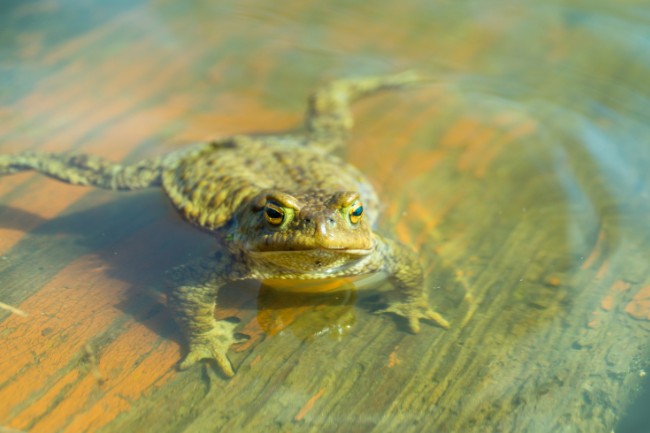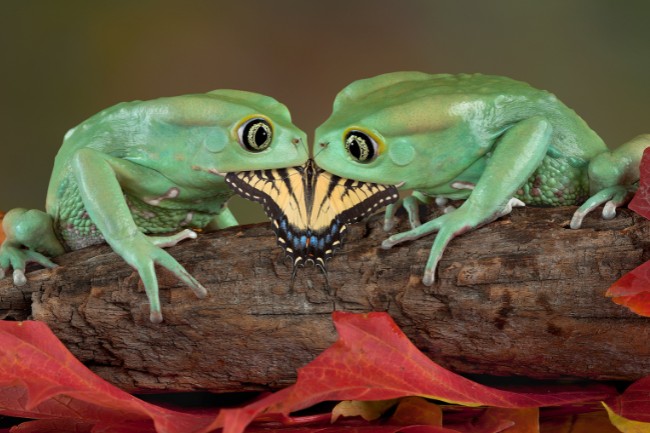Frogs don’t drink water by swallowing it with their mouths. Instead, they absorb it through special patches in their bellies, known as drinking patches.
How do they drink?
Frogs are amphibians, and like all amphibians have very thin skin. This thin skin comes with advantages and disadvantages. One of the disadvantages is that they lose water very quickly, meaning they are largely associated with damp habitats such as wet meadows, ponds and rivers.
By spending most of their time in cool, dark places, they reduce the risk of dehydration, which could quickly result in their deaths. They also have specialized glands on their skin that exude mucus. This layer of mucus helps keep them moist.
With such a serious disadvantage to being thin skinned, why do frogs put up with it? The upside of thin skin is something we may never consider possible based on our own biology. Frogs can both breath and drink through their skin.
| Frog Species | Hydration Strategy | Additional Information |
|---|---|---|
| Desert Rain Frog | Extracts moisture from sand and fog | Survives in arid regions by utilizing available moisture in the environment |
| Fire-bellied Toad | Absorbs water through its skin | Skin acts as a permeable barrier, allowing water absorption from the environment |
| Waterfall Frog | Immerses itself in water to stay hydrated | Lives in water-rich environments and stays hydrated by remaining submerged |
| Poison Dart Frog | Gains hydration from water-rich food sources | Acquires moisture by consuming prey items with high water content |
In both cases the mechanics are fairly simple. Blood vessels, close to the surface of the skin, allow an exchange of gases and liquids to occur through osmosis. Essentially, gasses and liquids pass through the skin because the they are higher on one side than the other, creating enough pressure to help them pass through.
Research has discovered that these blood vessels circulate more quickly if the frog is dehydrated, bringing water into the body more quickly. While frogs can technically absorb water through all their skin, the majority is absorbed through drinking patches, located on their bellies.

To aid the absorption of water, frogs will lay in puddles with their limbs outstretched, allowing maximum surface availability between the water and their drinking patches. While many species spend a great deal of time near waterbodies, such as ponds, lakes and rivers, many species of frogs will need to take advantage of whatever temporary pools of water are available, such as puddles of rainwater or pools accumulated within rotten wood.
| Frog Species | Water Source Preferences | Additional Information |
|---|---|---|
| Tree Frog | Dew, rainwater, water droplets on leaves | Well-adapted to arboreal environments and rely on moisture for hydration |
| Bullfrog | Ponds, lakes, slow-moving streams | Highly aquatic species that spend a significant amount of time in water |
| Dart Frog | Moisture on forest floor, water-filled plants | Obtains water through direct contact with moist surfaces and plant sources |
| African Clawed Frog | Aquatic environments, including rivers and swamps | Possess specialized skin adaptations for water absorption and respiration |
Also read: Here’s “How Frogs Find Ponds”
How do frogs swallow?
It may seem bizarre that frogs would choose to drink through their skin rather than their mouths. After all, they are perfectly happy to eat using their mouths, so why not drink too? Perhaps it is something to do with the mechanics of how a frog swallows.
Frogs do not have teeth, meaning that once the food is in the frog’s mouth, they don’t crunch down on it to break it up into smaller pieces. Instead, they simply swallow the food whole, and often alive, letting their stomach acids take care of it. In order to forced the food down their throat, they need to swallow. But to do this, frogs use a rather bizarre and unexpected body part; their eyes.
Frogs close their eyes and push them down into their mouths, so as for force food down their throats. While this works perfectly well with larger items such as flies or crickets, it might be more difficult on a liquid. Either this or absorbing water through their skin was simply so natural for them that they never bothered to investigate other options.

Also read: Wondering if “Frogs Eat Mice?”: Let’s Find Out
Do they need to drink?
Frogs do need to drink freshwater to survive. Amphibians can be very vulnerable to drying out, and can quickly dehydrate in dry conditions. Their thin skin also makes them very sensitive to pollution and can be the first species to react as habitat becomes degraded. If water sources become contaminated, their thin skin means they can easily take in toxins when absorbing water.
| Frog Species | Water Conservation Techniques | Additional Information |
|---|---|---|
| Spadefoot Toad | Burrows underground to escape arid conditions | Emerges from its burrow after rain to absorb water and rehydrate |
| African Reed Frog | Creates a waterproof cocoon to minimize water loss | Constructs a protective layer around its body to retain moisture |
| White’s Tree Frog | Stores water in its bladder for extended periods | Can store water in its urinary bladder and reabsorb it when needed |
| Tomato Frog | Develops a waxy layer on its skin to retain moisture | Produces a protective coating on the skin that reduces water loss |
Do pet frogs need water?
While frogs in the wild need to make do with whatever water they can find, pet frogs need to be provided with the right conditions to thrive. Although all frogs need water, frogs can survive in many different habitats. Some habitats can be particularly damp, such as rainforests, while others are drier.
It’s important therefore to provide pet frogs with the right conditions for the species, with some needing regular misting with water, while others only need water provided to drink from. In most cases frog owners will create shallow areas of water, big enough for the frogs to sit in, in order to drink. While most frogs can survive underwater for long periods of time, it’s essential that they can easily get out of the water again.

Happy as a frog in a puddle
Like all living things frogs need a certain amount of water to survive. How much water they need varies between species, with some frogs even adapting to life in deserts. But however much they may need, they all have an extra special way of taking a sip. Through their bellies.

